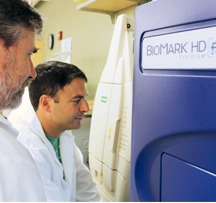New Genomic Equipment at TSRI Enables Scientists to Analyze Single Cells
By Madeline McCurry-Schmidt
Scripps Research Institute scientists now have access to equipment that enables research on the genetic roots of disease at the single-cell level. The Biomark HD System, housed in the Microarray Core Facility, was purchased through a grant from the National Institute of Health’s Shared Instrument Grant Program and is open to any researcher at the institute and outside of TSRI.
Over the last year, TSRI Professor Luc Teyton has experimented with the machine and shown that it can gather useful genomic data regarding immune cells involved in diabetes. He said researchers could also use the machine for studies of stem cells and cancer, which often track genes that originate in a single cell.
“Your resolution is finally going to be what you want,” said Teyton. “It has added power to many of the technologies we already have on campus.”
The Biomark, which is produced by the Fluidigm Corporation, solves several long-standing problems in genomic analysis. Scientists have been able to isolate single cells for some time, but current methods used to analyze them are not well developed and generally not of a high-throughput nature. The Biomark HD increases the throughput, creating thousands of data points for an experiment and increasing the statistical significance. To make this possible, the Biomark HD takes advantage of microfluidics and nanoliter-sized wells to combine 96 samples with each of the 96 target primers and uses a technique called quantitative PCR to measure gene expression levels.
The instrument also provides genotyping and analysis of protein expression or copy number variation. The Biomark HD can also create highly-multiplexed next-generation sequencing libraries, enriching for 48 or more target sites in 48 different samples. These highly-multiplexed libraries are retrieved from the Biomark HD and sequenced on a next generation sequencing instrument.
“It’s a fairly easy machine to use,” said Steve Head, director of the DNA Core Facility. Head said the machine can run up to 9,216 simultaneous tests on isolated cells. A typical analysis takes four to five hours and is fully automated.
The Biomark also solves the problem of how to handle human biopsy samples. Human tissue samples are notoriously small. If a researcher wants to analyze the immune cells from the body’s immune response to a tumor, for example, it can be very hard to find enough immune cells for analysis.
“Now you can get biopsies, isolate single T cells from those biopsies and do the work with them,” said Teyton. Those T cells could be used as models for creating immunotherapies to target tumors in individual patients.
Scientists interested in using the Biomark should email Head at shead@scripps.edu. The facility, located at 3040 Science Park on TSRI’s La Jolla, California campus, also offers Next Generation Sequencing, spotted custom arrays and classical microarray services.
Send comments to: press[at]scripps.edu














